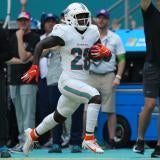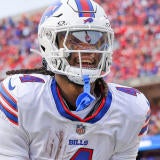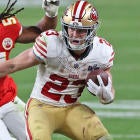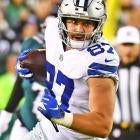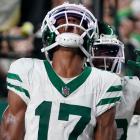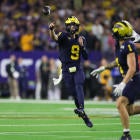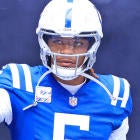Quarterback tiers | Running back tiers | Wide receiver tiers
Some Fantasy owners want a difference-maker at tight end -- and are willing to step up on Draft Day to get one. Some want a player with breakout potential or a long track record of success. Some want a bargain. Some want to gamble on a sleeper when the draft is half-over. And some see the position as a necessary evil and will take whatever's left at the end of a draft.
Which owner are you? If you know already, then you probably know when you'll draft a tight end and maybe even who it will be. But if you don't know which kind of owner you are, you won't be lost for much longer.
This year, the tight end tiers pretty much dictate your possible strategies.
Early birds
If you want a difference-making stud, it'll mean spending a Top 40 pick, if not Top 30. But you should get what you pay for.
Jimmy Graham is the king of tight ends right now, especially since he's officially been classified as such (appeal pending). Last year he overcame a bad (for him) 2012 to finish with 10 or more Fantasy points 12 times in 16 games. Keep in mind that eight Fantasy points for a starting tight end is considered good. In fact if we lower the bar to eight-plus Fantasy points then he's accomplished the feat 22 times in his last 31 games. He's a unique breed of player at the position and one that can make a weekly difference for your Fantasy team. That's why he's at the top of the food chain -- and why he'll cost a first-round pick. Maybe he'll slide to early Round 2 in smaller standard leagues but when owners are looking for a sure thing in Round 1, Graham is it.
Julius Thomas and Rob Gronkowski will be the next two tight ends taken in every draft, though the order will vary depending on Gronk's health. After taking forever to come back from a nightmare forearm injury last year (and a back problem, too), Gronk played in almost seven games before tearing his ACL. That happened in December, meaning he'd have slightly less than nine months of recovery time and rehab if he were to play in Week 1. He's risky not only to be effective right away, but to stay healthy for 16 games. That's why a lot of people would rather get Thomas, who broke out for the Broncos a year ago and could be in store for even more stats now that he has a year of great experience with Peyton Manning under his belt.
Thomas will get nabbed anywhere between the end of Round 2 and the end of Round 3. Gronk's a wild card who could go ahead of Thomas or a full round after him. But by the end of Round 4 these guys will be ancient history.
Remember, the point of taking one of these guys is to have a stable rock on your roster. If you draft one of them, you won't need to draft a backup since you'll never sit your superstud. And while you might come up light at another spot (like No. 2 running back or No. 2 receiver) on Draft Day, all it will take is some suave roster maneuvering to improve. There's more reward than risk, a rarity in Fantasy.
In the middle
The next group of tight ends have the potential to dominate but is more likely to be closer to seven or eight points a week rather than over 10. But they shouldn't require a pick any higher than late Round 5.
Vernon Davis is on the fence between these tiers, not quite a lock to have another big year statistically but not quite a lock for "just" eight points per week. The biggest factor is his status -- if Davis isn't in training camp anytime soon then his entire season is at risk since most players who miss camp struggle. He also has to keep up his torrid touchdown streak with Kaepernick: 15 touchdowns in 18 total games last season. We always expect a regression in touchdowns after a big year, particularly when a quarterback's favorite target returns to take red-zone looks away (in this case it's Michael Crabtree). But there's no denying Davis' abilities or role as the predominant game-wrecker in the Niners offense, which is expected to become more pass-heavy this year after averaging 26.0 attempts per game last year. But he must improve on his receiving yardage after averaging just 50.2 yards per game over 18 games. That number dipped a smidge to 43.9 yards per game in eight with Crabtree on the field, and the Niners bulked up at receiver this offseason. So consider Davis appropriately -- a sixth-round pick is fair.
The tight ends who will follow Davis off of most draft boards in some order are Jordan Cameron, Jason Witten, Greg Olsen and Dennis Pitta. You can almost count on these four being selected within a 20-pick span of each other to make up a tight end run of sorts. We've seen these runs begin in late Round 6 through late Round 7 as owners want to get a safe player with a track record of success. Cameron and Olsen stand to be the top receiving threats for their team, Pitta should be in line for a solid year now that he's healthy and in a tight-end-friendly offense and you can set your watch to Witten's stats as he's been Top 8 or better at the position in each of the last seven years.
Getting late, getting great?
The remaining tight ends that will get drafted as starters are players who could develop into top-tier tight ends ... or fall on their faces and frustrate you. The risk involved with these guys varies but the reward stands to be juicier than those of the previous tier.
Zach Ertz, Kyle Rudolph and Jordan Reed are young, prominent members of their offenses. All three are in systems that should pass a good amount (Rudolph and Reed's offenses should pass more than Ertz's though). And two of the three (Ertz and Rudolph) have the potential to finish as high as second on the team in targets (Reed should finish third behind Pierre Garcon and DeSean Jackson). They're all mismatch nightmares like Graham, too. But each have their flaws: Rudolph doesn't have blazing speed and will need those targets along with touchdowns to string together a big year. He's also battled injuries, as has Reed (multiple concussions last season, which is scary). Ertz is healthy by comparison and is a size-speed monster but the Eagles offense has many receiving threats and there could be some games where Ertz just isn't a big part of the game plan.
A lot of Fantasy owners like the idea of skipping over the second-tier tight ends and focusing on this trio because they carry as much if not more upside and can be had as soon as Round 8. That means you can shop for other positions before getting to a tight end.
Wait ... how many tight ends is that?!
So far we've successfully sorted through 11 tight ends. If you play in a league with 10 owners or less, assume that everyone will get a nice starter, making the position relatively deep. Nice!
But if we're in a league with 12 teams or more (and tight ends are mandatory) then there's a wee bit more pressure on owners to come up with a valid starter.
If you're in the position of being last to draft a starting tight end, shoot for the moon. Find a list of tight ends that have the potential to shatter expectations. And this year, that list should begin with a rookie.
Eric Ebron was drafted in Round 1 by the Lions, a total luxury pick given the state of their defense. They'll have to justify the selection by using him in the offense more than just a couple of times per game. But the excitement is in the details: Ebron is 6-foot-4 and 250 pounds, runs very well and will play the "Jimmy Graham role" in the Lions offense. He also won't see anything better than single coverage since the Lions also have Calvin Johnson, Golden Tate and their running backs for defenses to worry about. Now if that doesn't make your mouth water a little bit, I don't know what will. Just know that it's been a long time since a rookie tight end made a big splash in Fantasy Football (Gronk and Aaron Hernandez cracked the Top 12 as rookies in 2010).
Another young tight end with big size, good speed and an offense with a flair for the aerial attack is Ladarius Green. Chargers coach Mike McCoy lamented this offseason about how little he wound up using Green and all signs point to him being more involved in the Bolts' offense. One theory is that he'll actually play more as a receiver and less as a true tight end, thus putting him and veteran Antonio Gates on the field at the same time. Gates isn't a terrible Fantasy play, either, but it feels like he's at the end of his career and might finish, at best, 10th at the position. Green's the one with the upside.
But it's one last veteran who carries some supreme value and potential this summer -- Heath Miller with the Steelers. A long-time dependable target of Ben Roethlisberger, Miller should see a ton of targets as Big Ben works with a receiving corps that's undergone some turnover. He's caught at least 50 passes each of the last three years and will help make up for the losses of Emmanuel Sanders and Jerricho Cotchery around the goal line.
Not moonshots: Martellus Bennett, Delanie Walker, Charles Clay, Dwayne Allen. No doubt, these are good NFL tight ends. They just don't have solid track records for helping Fantasy owners. If you're in a pinch on Draft Day, these guys are good to roll with to begin the season, Bennett especially given his September track record. Just don't hesitate to punt on any of them for someone on waivers since there is a lot of inconsistency expected from this foursome.
Do you need more than one tight end?
Naturally, if you're in a league that requires two tight ends, you'll draft at least two. But most leagues demand one starting tight end, so most owners draft one and deal with the bye weeks later on. And most leagues that have a starting flex spot will allow a tight end to fill it if need be.
Before you daydream about dominating in a two-tight end formation, remember that a good week for a tight end is eight Fantasy points. Running backs and receivers can hit eight points with more frequency than most tight ends, plus there are more decent running backs and receivers to pick from than tight ends. So taking multiple tight ends isn't a must.
Unless ...
-- One of the tight ends from the top two tiers happens to fall in your drafts and right into your lap. In that rare instance, go for it. Value's value.
-- You aim to take one of the big three tight ends early on and swipe one of the risk-reward tight ends in Round 9 or later once you have your remaining roster spots settled.
Just keep in mind that the best plan of all could be to draft one tight end and wait for a breakout that we're not even thinking about (Jace Amaro? Timothy Wright?) to come available on waivers. Then you'll drop some mope for him and enjoy the benefits of having two tight ends. Won't cost you anything on Draft Day to do that!
Tiers
Frankly, I'm listing the tiers for those who were too lazy to read the article. Because if you did read everything above you'll know exactly who will go where. By now, everyone should know what kind of a tight end drafter they are. I don't mind aiming for one at the right price in the first three or four rounds, but if I whiff I'm aiming for one in Round 9 or later. I like Ertz a lot as a sleeper.
And it's worth mentioning that the whole point of tiers in the first place is to have a sense of when a group of players with a similar expectation is either readily available or getting thin.
| Elite Tier | Second Tier | Third Tier | Shoot for the moon | Fifth Tier |
| 1,000+ yards, 9+ TDs | 850+ yards, 6+ TDs | 700+ yards, 6+ TDs | ||
| Jimmy Graham | Vernon Davis | Zach Ertz | Eric Ebron | Martellus Bennett |
| Julius Thomas | Jordan Cameron | Kyle Rudolph | Ladarius Green | Delanie Walker |
| Rob Gronkowski | Jason Witten | Jordan Reed | Antonio Gates | Charles Clay |
| Greg Olsen | Heath Miller | Dwayne Allen | ||
| Dennis Pitta |








